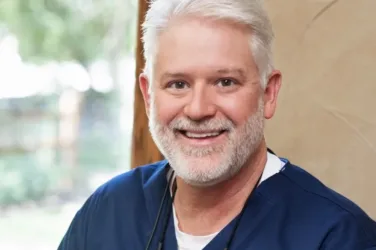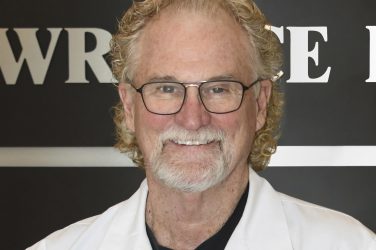
Q&A
Hospital
Why should I see an orthopedic surgeon when I don’t want to undergo surgery?
You should visit an orthopedic spine surgeon for neck or midback pain, pain traveling down your arm or leg, or lower back pain. It’s not a foregone conclusion that they’ll recommend surgery. In fact, if surgery is the first thing they recommend, I’d say find a different orthopedic surgeon.
What sorts of things should they recommend first?
Surgery should be the last-ditch effort to get you better, after you’ve tried physical therapy, activity modifications, injects, medication, and other treatment modalities. An orthopedic spine surgeon can coordinate these treatments for you. Surgery should be reserved for after we try all these things without the desired outcome.
When will I know it’s time to see an orthopedic surgeon and not just my primary care provider?
I’m always happy to see patients and always want to serve as a resource for them. That being said, if pain persists beyond a month, it’s time to see a spine surgeon. If neck pain goes down the arms or legs or you’re experiencing any kind of weakness, we’d like to see you sooner rather than later.
How has technology changed orthopedic surgery in recent years?
Technology has dramatically changed orthopedic surgery over the past 20 years, improving accuracy, personalization, and efficiency all while shortening recovery times. We’re still making steady advances within spine treatment — both surgical and non-surgical. I’m happy to be practicing at a time when spine surgery is less invasive with shorter recovery times. We also better understand the importance of maintaining motion to avoid problems and to facilitate return to activity after surgery.
How can I protect my joints and musculoskeletal health as I age?
Unfortunately, we will all develop arthritis of the neck and lower back as we age. It’s just a matter of the extent to which we’ll experience it. You can take steps to minimize the condition by eating a healthy diet, maintaining a proper weight, getting steady exercise, and avoiding nicotine products. While it’s not a bad idea to transition to less high-impact activities as you age, I think it’s more important to find activities you enjoy doing and do them. Whether it’s Pilates, yoga, walking, or hiking, if you enjoy it, you’re more likely to keep it up.
How important is medical collaboration in orthopedic care?
I like to spend time with each patient discussing the things we can do to make their quality of life significantly better without surgery. I look at us as a team — the patient and me as well as other medical professionals who can help them improve. That might be a physical therapist, chiropractor, and injection provider. My role is to help the patient develop that team and to monitor their progress once they do. Then, if surgery is indicated, I’ll coordinate with some of these same professionals to help the patient recover after surgery and return to their normal activities.
What trends are you seeing in your practice?
As an orthopedic surgeon, I concentrate on reconstruction, which is a subset of orthopedics. Traditionally, that’s meant older patients and those suffering with arthritis. But as the population as a whole has become more athletic, people are putting more strain on their knees, resulting in an increase in trauma and injury. I’ve been performing joint replacements for 28 years and, where I once rarely saw anyone below 60, I’m now performing knee replacements on patients in their 50s and younger.
When is it time to see an orthopedic surgeon, rather than my primary-care provider?
I’d say when symptoms persist. A strain or sprain can certainly be treated by your PCP. But if symptoms persist for more than a month, it might be time to see an orthopedic. Most people are looking for an answer to pain and disfunction and an orthopedic can help with that.
What non-surgical treatment options are available for patients trying to avoid surgery?
Plan A would be non-steroidal anti-inflammatories and physical therapy. Plan B will generally be steroid shot injections. We want to exhaust these non-surgical options before we discuss proceeding with surgery.
How can people protect their joints and musculoskeletal health as they age?
It’s vital to maintain mobility at any age. As you move past your 50s, your workouts should be less aggressive and more focused on maintaining mobility. Things like walking and yoga can help you maintain movement without jarring your joints. Above all, don’t be sedentary. Motion is lotion for your joints. Movement helps promote nutrition to joints. You want to get 30 minutes of less-aggressive
movement several times a week.
Your genetics are the biggest determining factor as to whether you get arthritis. Obesity can also contribute to a sedentary lifestyle.
How has technology changed orthopedic surgery in recent years?
Implants have continued to improve with knee replacement now expected to last 20 years. Robotic technology allows surgeons to be more precise and makes recovery much easier for the patient.
How can I prevent orthopedic injuries in everyday life?
That’s challenging since injuries come about through accident. As we age, the best way to prevent injury is to maintain activity, which promotes good balance. One of the biggest changes as we age is balance, which sets the stage for a fall.
One thing I always want to discuss with a patient before surgery is their plan for moving about their house after surgery, to prevent a fall. Take time to evaluate things like loose rugs, electrical cords, clutter, pets, poor lighting, and uneven surfaces. After surgery, you’re looking at two to three weeks on a walker and then graduating to a cane. Plan ahead to make your home walker and cane friendly. Then, give yourself time to heal. Pain tolerance has nothing to do with healing. The tissue needs time to heal. Overdoing it after surgery can be as bad as not moving. Instead, think of your recovery in stages. You can’t rush healing.
Baylor Scott & White Medical Center – Frisco is a hospital in which physicians have an ownership or investment interest. (The list of physician owners or investors is available to you upon request). Physicians provide clinical services as members of the medical staff and do not provide clinical services as employees or agents of Baylor Scott & White Medical Center – Frisco, Baylor Scott & White Medical Center – Centennial, UNITED SURGICAL PARTNERS INTERNATIONAL, BAYLOR SCOTT & WHITE HEALTH, or any of their subsidiaries or affiliates. ©2025 Baylor Scott & White Health.
About The Expert

Joseph Cruz Chavarria, MD
Baylor Scott & White Medical Center – Centennial
Dr. Chavarria is a fellowship-trained spine surgeon specializing in non-surgical and surgical spine interventions for a wide variety of neck and back conditions. He earned his bachelor’s degree from the University of Notre Dame and medical degree from Baylor College of Medicine. He completed residency at the University of Colorado and additional training at West Virginia University.
About The Expert

Dr. William Kemp Montgomery
Baylor Scott & White Medical Center – Frisco
Dr. Montgomery is certified by the American Board of Orthopedic Surgeons and has served the Frisco community for 20 years performing a large volume of hip replacements, total knee replacements, and partial knee replacements. He believes in treating the patient as a whole and bases his practice on personal relationships with each patient.











Show Comments